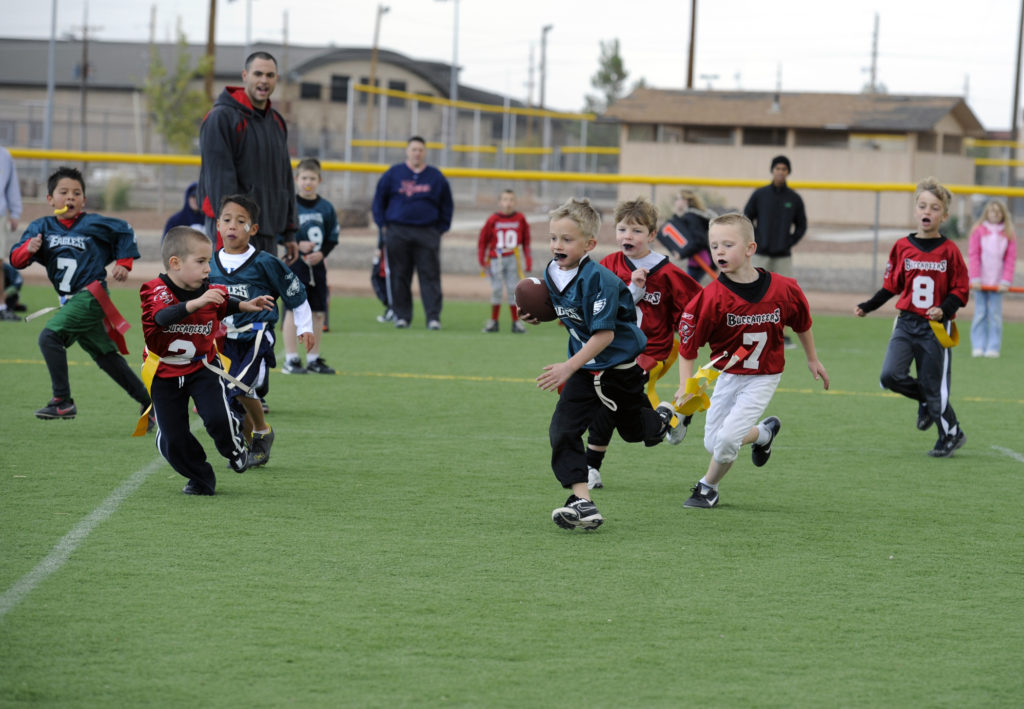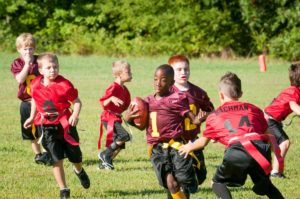Flag Football Drills for Kids

There are two ways to spend practice time.
The first is to repeat plays over and over. And while those improve tactical skills, they aren’t holistic enough.
Also, they miss out on other aspects of flag football, either overemphasizing offense tactics, or focusing too much on defense.
Also Read: Flag Football Positions
So there’s the second type of practice, which looks at drills. And below, we’ll explore both offense and defense drills.
We’ll also mention a warm-up routine to try!
(Warm Up): 2-Line Passing Warm Ups
This warm involves pairing up each kid on the team. They should be a short distance away from one another.
A rule to keep in-mind is to calculate distance based on each team member’s age. So if a child is 5-6 years old, they should be 5-6 yards apart.
If they’re 10 years+, then keep them 10 yards apart.
Every few minutes, have a child take some steps back. Let them repeat this for a few minutes (with the best being 5 to 10).
The goal here is to ensure a ball be thrown and received in the span of 10 seconds (with 6 catches and passes each minute).
This allows for 30 catches in total, which is normally enough for a good warm-up.
Flag Football Drills – Offense
Offense drills focus on agile motions (jukes, cut backs, spins), catching and passing, handoffs, and routine runs.
For now, we’ll focus on the handoff drills.
Handoff Drill
With younger practitioners, handoffs are important.
Youth need to learn how to perform a clean one without ball drops. They should also learn how to do so with speed.
Also Read: Basic Skills – Flag Football Drills for Kids
However, fumbles during practice are normal, especially if the players being coached are new to the sport.
But what’s important is to give each kid the opportunity to try and err with handoffs, which isn’t something they get enough of when playing a normal game.
Handoff Drill – Split Backfield
This drill repeats a play that should normally be practiced with new team member (especially if they’re less than 8 years old).
This drill has a quarterback perform the following…
• Fake it to the first.
• Run back crossing behind.
• Handing the ball to the following player running crosses.
This drill can be adapted based on the number of players at the practice.
In the best scenario, you’ll want 6 practicing this routine at a time. Thus, if you have a team of 12, you can split them into two groups, with each doing a different exercise.
Be sure to read up beforehand on laying out the drill (while using differently colored cones).
Inexperienced trainees will attempt to catch the ball using their hands.
You should force kids to use proper technique, leading a quarterback to put a ball into the cradle created by the run back as they pass by.
Ball Pass Drills
Outside of a game’s setting, many kids can throw and receive balls well. However, when you put them under the pressure of a game, you might find that they don’t perform as well.
This is what drill are for. Passing drills give children the feel of a game, while teaching them to catch throws on the fly.
It’s best done a workout or two after a warm up session.
Receiver Leading Drill
This drill requires setup.
You’ll start by marking certain areas on the field with cones. The goal here is for a receiver to catch balls being thrown inside those marked areas.
The goal of this area is to train quarterbacks in leading receivers to a specific area, rather than throwing at a receiver who is facing a quarterback (after running a hook).
Also, this exercise teaches receivers to sprint far from a defender after a ball catch, making it double as an excellent defense drill.
And speaking of defensive drills…
Flag Football Drills – Defensive
Defensive drills in flag football are diverse. And they have a multitude of goals.
One goal is to teach kids how to take on a proper angle when in pursuit of the other team.
It also teaches kids to coordinate themselves, learning how to run to other offensive players by judging where they’ll go, instead of where they currently are.
While those concepts do sound like fundamentals, they’re usually not well-ingrained in kids new to the sport.
Regardless, there are a multitude of exercises that’ll help kids hone their defense. They include man-to-man covering receivers, breaking on balls after they’re thrown, and drills for flag pulls.
Flag Pull Drill
This is a vital exercise, and is probably the most important for younger athletes.
Flag pulls include multiple drills which you can implement in practice. And those drills include…
1-On-1 Flag Pulls
Start this drill with offense running as fast as possible ahead, with defense cutting across while attempting to slow down ball carriers.
They should attempt to do so by getting ahead, then pulling the flags.
Also Read: Flag Football Games for Kids
This drill has the advantage of being fast-paced, so you can perform many repetitions in a short timeframe.
Special Workout: The Gauntlet drill
This is a highly recommended workout routine.
This drill is started by creating small running zones for the offensive side. Alternatively, you’ll have a single defender.
The remainder of the team will lineup on the other side. By signaling “go,” the offense player will attempt to beat the defense.
After a flag is pulled, the next runner is sent in. Here, the defender has to learn quick processing, attempting to pulls as many possible flags.
Flag Football Drill –Advanced Skill Developement

Ball Handling- Combination Drill
This youth flag football drill combines several basic drills in to one combination to improve your players’ ability to execute a running play. The Drill uses a team or 3 or optionally 4 (see below) – Center, quarterback and running back, and optionally a Linebacker.
- Center lines up over the ball utilizing proper snap techniques
- Quarterback lines up under center and calls hike and receives the snap.
- The running back can line up a several designated spots in the back field, depending on how your playbook is designed. Each time the drill is run the RB should change positions, so that he and the quarterback can practice different hand-off techniques.
- The running back moves in the proper line to except a hand-off from the quarterback
- The running back carries the ball 10 yards down the field.
- Optional Add a line backer 10 yards down field. Once he sees the hand-off, the LB should move forward and attempt to pull the flag of the running back.
It’s best to start this drill at half speed at first, but after a few tries the players should practice running this drill at full speed.
WR Route Running & Pass Receiving Combination Drill
In this simple drill QB & WR practice different route running and pass catching techniques. The focus is on the QB hitting the receiver in stride and/or with proper timing, and of course the receiver running the proper route and catching the ball.
- Either the coach or the QB calls the pattern to execute.
- On “hike” the center snaps the ball to the QB and the WR starts their routes. Emphasise proper stance and an explosive start off the LOS.
- The QB throws the pass to the WR, the WR then catches the ball and runs down field for 10-15 yards. Insure the WR secures the ball and turns up field immediately.
- Next player goes. Every player can run the same pattern or each player can be called for a different pattern depending on the Coach’s goals for the day.
- Optionally the Coach can add a defender into the mix once the players have advanced enough.
2-on-1 Team Flag Pulling Drill
A more complex drill that will help you coach your players to work as a team when pulling the flag of a ball carrier.
- Start by mapping out the running area with cones. The running area should be a rectangle roughly 20 yards long by 5 yards wide. One side of the rectangle represents the sideline.
- Select 2 players at a time to be defenders. Defender 1 should stand 10 yards from the sideline at the mid point (10 yards deep) of the rectangle. The second defender lines up approx. 10 yards deeper and 15 yards from the sideline.
- Select 1 player to be the ball carrier. When the drill begins the ball carrier attempts to traverse the running area starting at one end and moving 30 yards down field to the opposite end. The idea is that this player represents a runner who has “turned the corner” and is attempting to sprint down the sideline to the end zone.
- Defender 1 attempts to stop the ball carrier by moving forward to block his way and protect the sideline, forcing the runner back towards the middle of the field. His primary concern should be stopping the progress of the runner, since he knows assistance is coming. He should attempt to pulling the flag only after he is in good position with the sideline protected.
- Defender 2 must race down field to fill the cutback lane and assist defender 1 in pulling the flag while barring the runner from moving into the center of the field.
Its important to emphasize the following points:
- The defender should move forward and attack the runner, not sit back and wait.
- At the end of the drill both defenders should be very close together, so that there is no gap for the ball carrier to dart between them.
- Defender 1 should “protect the sideline” by positioning himself so that there is no room for the runner to pass to the outside without stepping out of bounds.
SAQ Drills – Click this link to read our article and video about speed and agility ladder drills.








